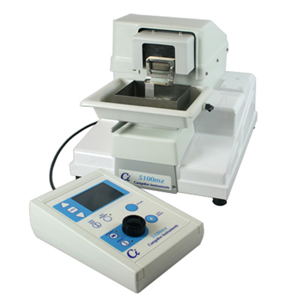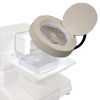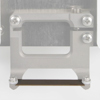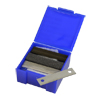

5100mz-plus
Vibrotome - Vibrating Microtome. The 5100-Plus is perfect for those who need to keep slices viable for longer e.g. for electrophysiological field recordings
- Overview
- Specifications
- Accessories
- Citations
- Related Products
Overview

There are 1 images available to view - click to enlarge and scroll through the product gallery.
Instruction Manual
/ Download as PDF
The 5100-Plus is perfect for those who need to keep slices viable for longer e.g. for electrophysiological field recordings. The user can calibrate the Z-axis deflection of the blade to 2 µm with the adjustable blade holder and “Opti-cal” Calibration device. Minimal Z-axis deflection reduces the “chatter” and minimises damage to the slice surface, leading to greater viability of the cells on the slice surface.
The New 5100mz series Vibrating Microtome shares the User interface with the premium 7000smz-2, placing a wide range of adjustable parameters at the user’s fingertips:
- Includes the Z-axis calibration unit (5100mz-Plus only)
- Vibration frequency from 50 to 80 Hz
- Adjustable amplitude from 0.5mm to 1.5mm
- Fine control of the blade advance (min. 0.1 mm/sec)
- Set start and stop position of blade travel
- Control box on umbilical cord ideal for operation in an isolated environment
- Set start and finish position of blade travel
- Remote controls allowing for sterile use in culture hood
- Ice water bath easily removed for cleaning
Use in fully manual or the semi-automated "Slice window" mode which automatically remembers the start and finish position of the slice.
Optional cold light and magnifier available for clear observation
Optional Peltier cooled bath available
Specifications
| Section thickness step size: | 0.001 mm |
| Bath table rise & fall speed: | 1.0 mm/sec maximum |
| Maximum (vertical) travel of bath table: | 19 mm |
| Cutting head advance speed | Minimum: -2.0 mm/sec (-1.00 during slicing) Maximum: +2.0 mm/sec (+1.00 during slicing) |
| Cutting head retraction speed: | 2.0 mm/sec |
| Maximum travel of cutting head: | 40 mm |
| Blade oscillation frequency | Minimum: 50 Hz Maximum: 80 Hz (amplitude dependent) |
| Frequency step size: | 5 Hz |
| Blade oscillation amplitude | Minimum: 0.5 mm (nominal) Maximum: 1.5 mm (nominal) |
| Amplitude step size: | 0.5 mm (nominal) |
| Power requirements (Selectable): | 115VAC 60Hz, 230VAC 50Hz |
| Power rating: | 100W |
| Fuse rating (115V): | T2A 250VAC |
| Fuse rating (230V): | T2A 250VAC |
| Light source: | Powered from 5100mz |
| Dimensions: | 350mm Width x 450mm Depth x 350mm Height (excluding magnifier/light source) |
| Weight: | 15kg (excluding magnifier) |
| Boxed shipping weight: | tba |
Accessories
5100-1-3
Integrally Mounted Cold Light Source and Magnifying GlassA magnifying glass for general...
7550-1-C
Specialized Ceramic blades for Vibrating Microtomes. These blades are honed with a sing...
7550-1-SS
Stainless Steel Blades - 50 pack;Recently redesigned following customer feedback and ap...
Citations
Ahumada, J., Sevilla, D., & Couve, A. (2013). Long-term depression of inhibitory synaptic transmission induced by spike-timing dependent plasticity requires coactivation of endocannabinoid and muscarinic. …. Retrieved from https://onlinelibrary.wiley.com/doi/10.1002/hipo.22196/full
Cymerblit-Sabba, A., Schiller, M., & Schiller, Y. (2013). Termination of Chemoconvulsant-Induced Seizures by Synchronous and Asynchronous Electrical Stimulation of the Hippocampus In-Vivo. Brain stimulation. Retrieved from https://www.sciencedirect.com/science/article/pii/S1935861X13000880
Graupner, M., & Reyes, A. (2013). Synaptic Input Correlations Leading to Membrane Potential Decorrelation of Spontaneous Activity in Cortex. The Journal of Neuroscience. Retrieved from https://www.jneurosci.org/content/33/38/15075.short
Jang, H., Cho, K., & Kim, M. (2013). Layer-and cell-type-specific tonic GABAergic inhibition of pyramidal neurons in the rat visual cortex. Pflügers Archiv-European …. Retrieved from https://link.springer.com/article/10.1007/s00424-013-1313-1
Lao, C., Lu, C., & Chen, J. (2013). Dopamine D3 receptor activation promotes neural stem/progenitor cell proliferation through AKT and ERK1/2 pathways and expands type-B and-C cells in adult. Glia. Retrieved from https://onlinelibrary.wiley.com/doi/10.1002/glia.22449/full
Li, Y., & Wang, J. (2013). Membrane Insertion of New AMPA Receptors and LTP Induced by Glycine is Prevented by Blocking NR2A-Containing NMDA Receptors in the Rat Visual Cortex In. Current neurovascular research. Retrieved from https://www.ingentaconnect.com/content/ben/cnr/2013/00000010/00000001/art00009
McGee, T. (2013). Copper block of extrasynaptic GABAA receptors in the mature cerebellum and striatum. The Journal of …. Retrieved from https://www.jneurosci.org/content/33/33/13431.short
Moon, Y., Kim, J., Kim, W., & Kim, H. (2013). Function of Ezrin-Radixin-Moesin Proteins in Migration of Subventricular Zone-Derived Neuroblasts Following Traumatic Brain Injury. STEM …. Retrieved from https://onlinelibrary.wiley.com/doi/10.1002/stem.1420/full
Revest, J., & Roux, A. Le. (2013). BDNF-TrkB signaling through Erk1/2MAPK phosphorylation mediates the enhancement of fear memory induced by glucocorticoids. Molecular …. Retrieved from https://www.nature.com/mp/journal/vaop/ncurrent/full/mp2013134a.html
Uribe-Querol, E. (2013). Selective and constructive mechanisms contribute to neural circuit formation in the barrel cortex of the developing rat. … in Bioscience & …. Retrieved from https://search.ebscohost.com/login.aspx?direct=true&profile=ehost&scope=site&authtype=crawler&jrnl=21568456&AN=91607134&h=noLPbvB7DEJIriMau8lqkyoHiQp1klni4UHg%2Ba3TqUbYgzHQxJLUjF1ZbOHbPfemVvSfKz2wuHUBoEq%2BiQQ%2B8w%3D%3D&crl=c







Request
Catalogue
Chat
Print